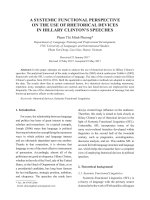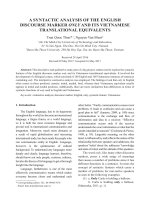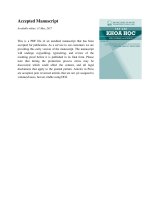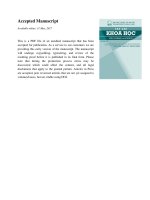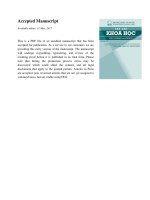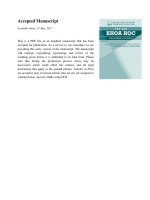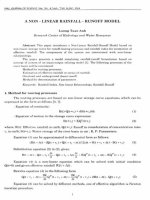DSpace at VNU: A 8x1 Sprout-Shaped Antenna Array with Low Sidelobe Level of -25 dB
Bạn đang xem bản rút gọn của tài liệu. Xem và tải ngay bản đầy đủ của tài liệu tại đây (2.56 MB, 7 trang )
Accepted Manuscript
Available online: 31 May, 2017
This is a PDF file of an unedited manuscript that has been
accepted for publication. As a service to our customers we are
providing this early version of the manuscript. The manuscript
will undergo copyediting, typesetting, and review of the
resulting proof before it is published in its final form. Please
note that during the production process errors may be
discovered which could affect the content, and all legal
disclaimers that apply to the journal pertain. Articles in Press
are accepted, peer reviewed articles that are not yet assigned to
volumes/issues, but are citable using DOI.
VNU Journal of Science: Comp. Science & Com. Eng., Vol. 33, No. 1 (2017) 22–27
A 8×1 Sprout-Shaped Antenna Array
with Low Sidelobe Level of -25 dB
Tang The Toan1 , Nguyen Minh Tran2 , Truong Vu Bang Giang2,∗
1 University
2 VNU
of Hai Duong
University of Engineering and Technology, Hanoi, Vietnam
Abstract
This paper proposes a 8 × 1 sprout-shaped antenna array with low sidelobe level (SLL) for outdoor point to
point applications. The array has the dimensions of 165 mm × 195 mm × 1.575 mm and is designed on Rogers
RT/Duroid 5870tm with the thickness of 1.575 mm and permittivity of 2.33. In order to achieve low SLL, Chebyshev
distribution weights corresponding to SLL preset at -30 dB has been applied to design the feed of the array. Unequal
T-junction dividers have been used to ensure that the output powers are proportional to the Chebyshev amplitude
distribution. A reflector has been added to the back of the antenna to improve the directivity. The simulated results
show that the proposed array can work at 4.95 GHz with the bandwidth of 185 MHz. Moreover, it can provide
the gain up to 12.9 dBi and SLL suppressed to -25 dB. A prototype has also been fabricated and measured. A
good agreement between simulation and measurement has been obtained. It is proved that the array can be a good
candidate for point to point communications.
Received 23 February 2017, Revised 27 February 2017, Accepted 27 February 2017
Keywords: Linear microstrip antenna array, Chebyshev distribution, Low sidelobe.
1. Introduction
undesired direction, low SLL arrays has captured
great attention from designers and researchers
worldwide. Nevertheless, microstrip antenna
arrays have faced the difficulty of gaining low SLL
as being affected by the spurious radiation form the
feeding network. Thus, in order to achieve relative
SLL of 20 dB or below, the feeding network
should not be on the same substrate face with the
radiation patch [2]. It means that the low SLL
microstrip antenna arrays must have at least two
layers to distinguish the radiation element and the
feeding network. This makes the antennas more
complicated to manufacture, and larger in size.
Outdoor point to point access points often
require high gain antenna to enhance the coverage
and signal quality [1]. Moreover, modern wireless
systems, nowadays, are often equipped with
microstrip antennas which have benefits of low
profile, light weight and easy integration. In
order to get high gain, microstrip arrays have been
employed, but conventional ones will generate
high SLL which wastes energy in undesired
directions and gets interferences to the systems.
Therefore, due to the abilities of minimization of
interferences and saving the energy radiated in
∗
To gain low SLL in microstrip antenna arrays,
the feeding network can be designed to get the
output signals in accordance with the amplitude
Corresponding author. Email.:
/>
22
T. V. B. Giang / VNU Journal of Science: Comp. Science & Com. Eng., Vol. 33, No. 1 (2017) 22–27
distribution. There are some common amplitude
weighting methods, for example Binomial,
Chebyshev, and Taylor [3]. Of three methods,
Chebyshev arrays are preferable due to having
optimum beamwidth for a specified SLL [3, 4].
Among three methods, Chebyshev arrays can
provide better directivity with lower SLL [5].
In the literature, a number of low SLL linear
microstrip arrays that applied Chebyshev amplitude
distribution have been studied and introduced. In 1989,
J. Wang and J. Litva introduced a new design for low
sidelobe microstrip antenna array [6]. The antenna,
which consists of 10 rectangular patches, can achieve
-25 dB SLL. However, to minimize the effects of
the feed on the radiation of the arrays, the feed is
quite large. In [7], a microstrip linear antenna array
with 5 elements, fed by Chebyshev amplitude weights
and has been proposed. The array has a smaller size
but can only get -17 dB of SLL. Another 5×1 linear
array antenna with side lobe suppression has been
proposed by Y. P. Saputra [8]. The antenna can only
provide SLL around -20 dB at the frequency of 9.3
GHz. Several corporate feed arrays with low SLL has
been designed and presented in [9, 10]. A. Nesic has
introduced the design of printed antenna arrays with
high side lobe suppression [9, 11]. The array with 8
double side printed dipoles can achieve a high gain of
20 dB with SLL of -34 dB. However, to increase the
gain, corner reflector consisting of two metal plates
has been added, and this makes the antenna bigger
and more complicated to fabricate. The authors in
[10] presented the design of a low sidelobe collinear
antenna array with 8 printed dipole elements. This
array can achieve -25 dB SLL and gain of around
15 dB. However, the array has 3D structure so that
it is also difficult to fabricate. Another 8×1 aperture
coupled patch linear array has been proposed in [12].
Although having 3 layers to distinguish the radiation
patch and the feed, the array can only acquire about
-18 dB SLL.
In order to diminish the spurious radiation from
the feeding network, some researches about series
feed arrays have been done [13, 14]. In [13], an
aperture coupled microstrip antenna array with
23
low cross-polarization, low SLL and backlobe
has been given. The array was designed with
a good matched feeding network and can offer
low SLL of -20.9 dB. The array consisting of 6
microstrip patches has been designed to suppress
the sidelobes [15]. Though applying Chebyshev
weights, this antenna can only get -16 dB sidelobe
suppression. [16] presented a low SLL series fed
dielectric resonator antenna (DRA) array with 22
elements. This antenna can achieve SLL of -30
dB, but it is impractical as it is really lengthy. W.
Shen, J. Lin, and K. Yang have introduced two
low SLL and wideband series feed linear DRA
array in [17, 14]. The two antennas have the SLL
of -23 dB and -27 dB, respectively. However,
those proposals are difficult to fabricate due to
the complex structure of the feeding network (2-3
layers) that may cause high fabrication tolerance.
In the authors’ previous work, the analysis and
procedure to design the feeding network using
Chebyshev weighting method has been presented
in [18]. This procedure has been used to build the
feeding network of the array in this work.
In this work, we proposed a low SLL linear
microstrip antenna array that has simple structure
to fabricate using printed circuit board (PCB)
technology. The array consists of 8 double-sided
printed dipoles (DSDP). The Chebyshev amplitude
weights (corresponding to SLL of -30 dB) has
been used in designing the feeding network of
the array to gain low SLL. The simulation results
indicate that the antenna can operate at 4.95 GHz
with bandwidth of 185 MHz. Moreover, the
simulated gain and SLL are 12.9 dBi and -25 dB,
respectively. A prototype has been fabricated and
measured. Good agreement between simulation
and measurement has been obtained. The detailed
of the design will be presented in the next section.
2. Antenna Array Design and Construction
2.1. Single Element
Possessing the advantages of small size and
wide bandwidth outweigh other printed antennas,
T. V. B. Giang / VNU Journal of Science: Comp. Science & Com. Eng., Vol. 33, No. 1 (2017) 22–27
24
Figure 2. Proposed Chebyshev feeding network.
Figure 1. Proposed single element.
Table 1. Parameters of the single element (unit: mm)
Parameters
w1
w2
w3
c
Value
1.25
7.375
10.5
2.5
Parameters
L1
L2
L3
L4
Value
7
2.5
7.5
5
DSDP has been used as the single element to
construct the array. The analysis and formulas to
design this kind of element have been specifically
demonstrated in authors’ previous work [19]. The
antenna has been designed on Rogers RT/Duroid
5870 tm using the formulas mentioned in [19]. The
final single element has been optimized and shown
in the Figure 1.
2.2. Feeding Network Design
After having the single element, a feeding
network has been designed. Chebyshev weights
for SLL preset at -30 dB (as given Table 2) is
used to gain low SLL. To design the feeding
network with output signals being proportional
to the Chebyshev weights, the unequal T-junction
dividers has been used. Figure 2 shows the final
feeding network in this work.
It is observed that the Chebyshev coefficients
are symmetrical at the center. Therefore, with even
number of elements, an equal T-junction power
divider, D1 , has been designed to ensure that two
sides are identical. The combination of dividers,
Figure 3. Proposed microstrip linear array.
D2 , is calculated and designed in order to match
the first four weights of Chebyshev distribution.
After that, the divider D2 is mirrored at the center
of the divider D1 to get the full feeding network.
Each port has been designed with uniform spacing
to ensure that the output signals are in phase.
The array was constructed by combining the
single element with the feeding network. A
reflector which made of double sided copper
cladding FR4 epoxy has been added at the back
of the array to improve the directivity of the
array. Figure 3 presents the final array with the
Chebyshev distribution feeding network.
T. V. B. Giang / VNU Journal of Science: Comp. Science & Com. Eng., Vol. 33, No. 1 (2017) 22–27
25
Table 2. Chebyshev amplitude weights for 8×1 linear array with the inter-element spacing = 0.5λ (SLL = -30 dB)
Element No. (n)
1
2
3
4
5
6
7
8
Normalized amplitude (un )
0.2622
0.5187
0.812
1
1
0.812
0.5187
0.2622
Amplitude distribution (dB)
-19.9
-13.98
-10.08
- 8.27
-8.27
-10.08
-13.98
-19.9
(a) Normalized radiation pattern of the array
Figure 4. Simulated S 11 of the array.
Table 3. Summary of simulation results
Parameters
Center frequency
Bandwidth at RL ≤ -10 dB
Gain
SLL
Simulation data
4.95 GHz
185 MHz
12.9 dBi
-25.2 dB
3. Simulation, Measurement and Discussions
(b) Gain in 3D
3.1. Simulation Results
Figure 4 presents the simulation results of Sparameters of the array. It can be seen from the
simulated result that the resonant frequency of
the antenna is 4.95 GHz, and the bandwidth is
185 MHz.
The simulation of the radiation pattern of the
sprout-shaped antenna array in E and H planes and
in 3D have been shown in the Figure 5. It is clear
that the array can provide the gain of 12.9 dBi and
the low SLL of -25.2 dB.
Figure 5. Radiation pattern of the sprout-shaped
antenna array.
3.2. Measurement and Discussion
A prototype has been fabricated to validate the
simulation data. Figure 6 gives the fabricated
sample. The sample has been then measured,
and the measured data was compared with the
simulation result as shown in Figure 7.
T. V. B. Giang / VNU Journal of Science: Comp. Science & Com. Eng., Vol. 33, No. 1 (2017) 22–27
Figure 6. Array prototype.
26
the dimensions of 165 mm × 195 mm × 1.575
mm and is designed on Rogers RT/Duroid 5870tm
with the thickness of 1.575 mm and permittivity
of 2.33. In order to achieve low SLL, Chebyshev
distribution weights (preset sidelobe level of -30
dB) has been applied to the feed of the array.
The simulated results show that the proposed
array can provide the gain up to 12.9 dBi and
SLL suppressed to -25 dB. A prototype has also
been fabricated and measured. Good agreement
between simulation and measurement has been
obtained. It is proved that the array can be a good
candidate for applications such as point to point
communications, WLAN.
Acknowledgement
This work has been partly supported by Vietnam
National University, Hanoi (VNU), under project
No. QG. 16.27.
References
Figure 7. Comparison between simulated and measured S 11 .
It is observed that a good agreement between
measurement and simulation has been obtained.
The simulated bandwidth of the array is about
185 MHz, while the counterpart in measurement
is around 260 MHz. The resonant frequency is
shifted a little bit due to the fabrication tolerance.
However, it is still able to work well in the whole
simulated bandwidth.
4. Conclusions
In this paper, a 8×1 sprout-shaped antenna array
with low sidelobe level (SLL) for point to point
applications has been proposed. The array has
[1] Aruba Networks, “Outdoor point-to-point deployment”,
Tech. Rep. version 1.0, Aruba Networks, Inc.,
Airwave c at al., 1344 Crossman Avenue, Sunnyvale,
California 94089, 2011.
[2] D. M. Pozar and B. Kaufman, “Design considerations
for low sidelobe microstrip arrays”, IEEE Transactions
on Antennas and Propagation, vol. 38, no. 8, pp. 1176–
1185, Aug. 1990.
[3] C. A. Balanis, Antenna Theory Analysis and Design, 3rd
edt., John Wiley & Sons, Inc., Publication, Hoboken,
New Jersey, 2005.
[4] N. S. Khasim, Y. M. Krishna, J. Thati, and M. V.
Subbarao, “Analysis of different tappering techniques
for efficient radiation pattern”, e-Journal of Science &
Technology (e-JST), pp. 47–53, 2015.
[5] A. T. Abed, “Study of radiation properties in taylor
distribution uniform spaced backfire antenna arrays”,
American Journal of Electromagnetics and Applications,
vol. 2, no. 3, pp. 23–26, Aug. 2014.
[6] J. Wang and J. Litva, “Design study of a low sidelobe
microstrip antenna array and feed network”, in Digest
on Antennas and Propagation Society International
Symposium, Jun. 1989, pp. 882–885 vol. 2.
[7] A. Yoseaf, N. Fahoum, and H. Matzner, “A linear
microstrip antenna array having low sidelobe level”,
in 2009 3rd European Conference on Antennas and
Propagation, Mar. 2009, pp. 1166–1170.
T. V. B. Giang / VNU Journal of Science: Comp. Science & Com. Eng., Vol. 33, No. 1 (2017) 22–27
[8] Y. P. Saputra, F. Oktafiani, Y. Wahyu, and A. Munir,
“Side lobe suppression for x-band array antenna using
dolph-chebyshev power distribution”, in 2016 22nd
Asia-Pacific Conference on Communications (APCC),
Aug. 2016, pp. 86–89.
[9] A. Neˇsi´c, I. Radnovi´c, and Z. Mi´ci´c, “Printed antenna
arrays with high side lobe suppression”, Active and
Passive Electronic Components, vol. 2008, 2008.
[10] C. Lin, F. S. Zhang, F. Zhang, and Z. B. Weng, “A
compact linearly polarized antenna array with low
sidelobe”,
in 2010 International Conference on
Microwave and Millimeter Wave Technology, May 2010,
pp. 384–387.
[11] M. Milijic, A. Nesic, and B. Milovanovic, “Printed
antenna arrays with high side lobe suppression: the
challenge of design”, in Microwave Review, Dec. 2013,
pp. 15–20.
[12] K. M. Aghdam, R. F. Dana, G. A. E. Vandenbosch,
and W. De Raedt, “Fan and pencil beam aperture
coupled patch antenna array with low sidelobe level”,
in Proceedings of the Fourth European Conference on
Antennas and Propagation, Apr. 2010, pp. 1–4.
“A novel
[13] J. Xiao, G. Dong, and M. Zhu,
aperture coupled microstrip antenna array with low
cross-polarization, low sidelobe and backlobe”, in
ICMMT 4th International Conference on, Proceedings
Microwave and Millimeter Wave Technology, Aug.
2004, pp. 223–226.
27
[14] W. Shen, J. Lin, and K. Yang, “Design of a v-band
low sidelobe and wideband linear dra array”, in
2016 Progress in Electromagnetic Research Symposium
(PIERS), Aug. 2016, pp. 477–480.
[15] C. Niu, J. She, and Z. Feng, “Design and simulation of
linear series-fed low-sidelobe microstrip antenna array”,
in 2007 Asia-Pacific Microwave Conference, Dec. 2007,
pp. 1–4.
[16] M. Ranjbar Nikkhah, J. R. Mohassel, and A. A.
Kishk, “A low sidelobe and wideband series-fed
dielectric resonator antenna array”, in 2013 21st Iranian
Conference on Electrical Engineering (ICEE), May
2013, pp. 1–3.
[17] J. Lin, W. Shen, and K. Yang, “A low sidelobe and
wideband series fed linear dielectric resonator antenna
array”, IEEE Antennas and Wireless Propagation
Letters, vol. 16, pp. 513–516, 2016.
[18] T. T. Toan, N. M. Tran, and T. V. B. Giang, “A feeding
network with chebyshev distribution for designing low
sidelobe level antenna arrays”, accepted to be published
in VNU Journal of Science: Computer Science and
Communication Engineering, 2017.
[19] T. T. Toan, N. M. Tran, and T. V. B. Giang, “A new
approach to design and optimize double-sided printed
dipole antennas”, in The 2016 National Conference
on Electronics, Communications, and Information
Technology (REV-2016), Dec. 2016, pp. 2/21–2/24.

